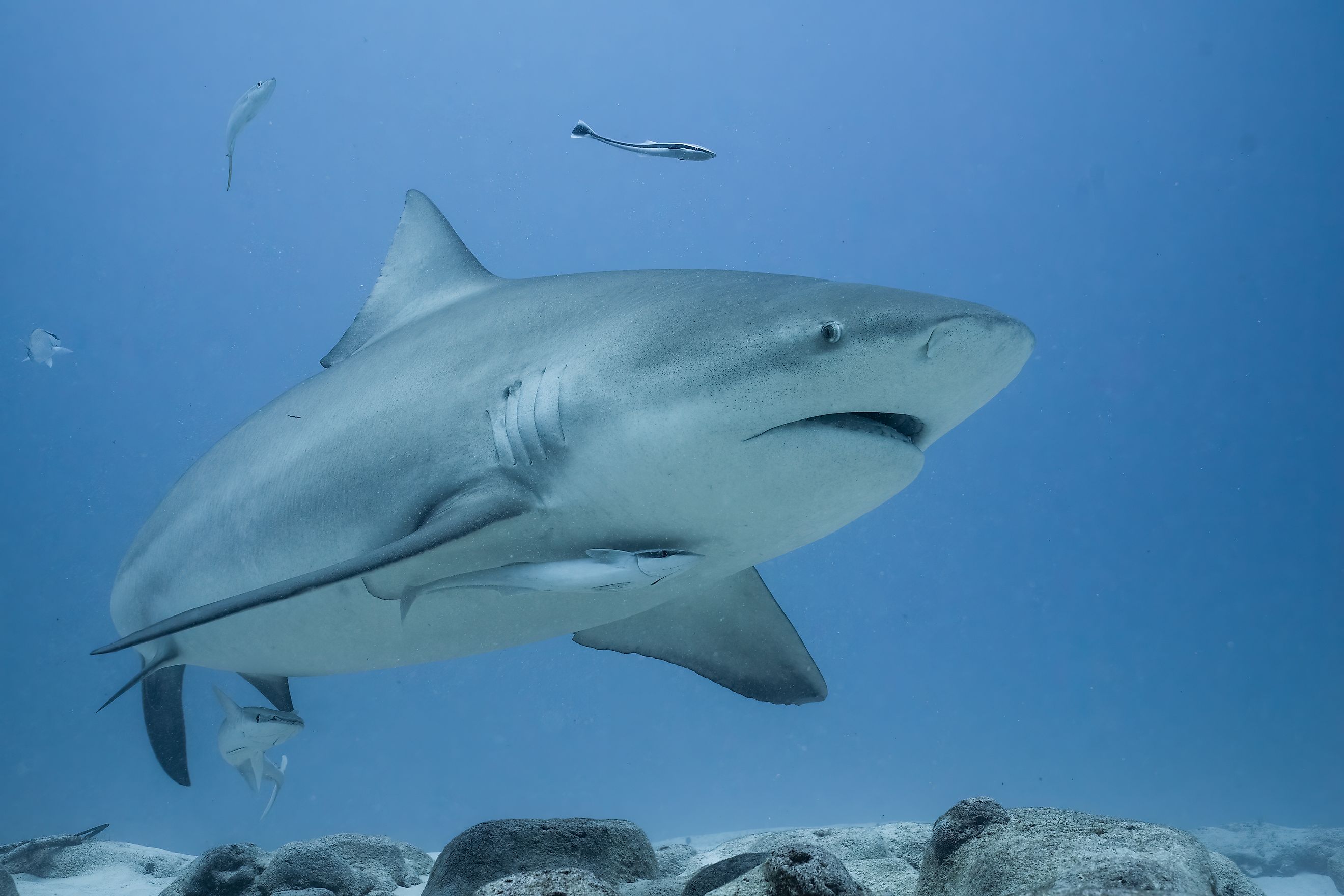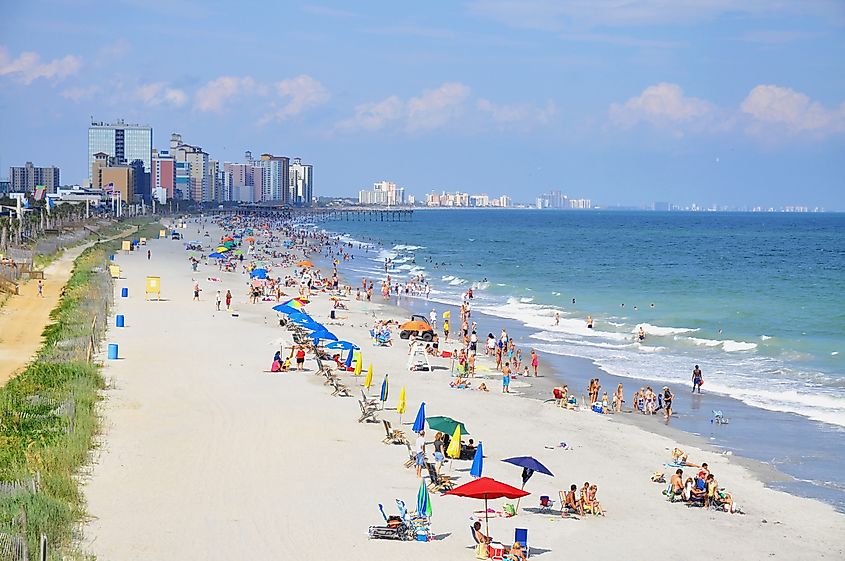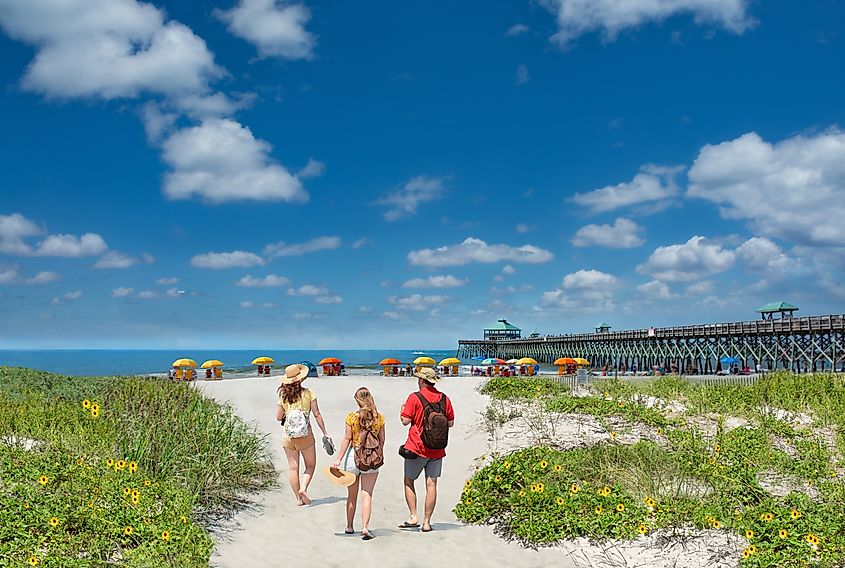
5 Most Shark Infested Beaches In South Carolina
The beautiful emerald-green waters off the coast of South Carolina draw millions of sun-loving beachgoers every year. But tourists aren’t the only visitors who flock to the beaches for sun and surf; sharks are drawn to the state’s estuaries, piers, and fishing holes, where schools of fish provide an endless buffet. But sharks tend to get a bad rap, thanks partly to the 1975 cult classic Jaws, whose unofficial tagline, “Don’t Go in the Water,” frightened swimmers out of the Atlantic Ocean for years. In reality, sharks rarely attack, with only a few species, like the great white, tiger, and bull shark, being territorial and aggressive.
According to the International Shark Attack File (ISAF) at the Florida Museum of Natural History, 36 “unprovoked” shark bites were in the US in 2023. An “unprovoked” shark bite occurs when a shark attacks a person in the ocean without being harassed by someone attempting to feed or touch a shark. South Carolina had two reported shark bites in 2023, ranking behind Florida and Hawaii.
Myrtle Beach

View of Myrtle Beach South Carolina.
Myrtle Beach is a popular South Carolina vacation hotspot, with more than 17 million visitors attracted to its 60 miles of beautiful sandy beaches, famous boardwalk, vibrant nightlife, and Southern hospitality. The Myrtle Beach area is called the Grand Strand and comprises 14 communities along the South Carolina coast. It is known for frequent shark sightings, particularly during summer. Several species, including blacktip and spinner sharks, are common. On average, Myrtle Beach reports one to two shark attacks per year, resulting in minor injuries. On August 15, 2022, two people were bitten by sharks on the same day off the coastline of Myrtle Beach.
Still, given the millions of visitors to Myrtle Beach annually, the incidents are relatively rare. Most incidents occur from late spring to early fall, which mirrors the migratory patterns of sharks moving through the warm waters. Fishing attracts sharks closer to shore, especially near fishing piers where fish are being cleaned, or plenty of bait can be found. Sharks are more active during dawn and dusk, popular times for anglers looking to reel in the catch of the day.
Sea Pines Beach

Lemon shark close up with Remora Fish.
Sea Pines Beach is at the very south tip of Hilton Head Island—a picturesque barrier island off the coast of South Carolina. The beach is part of a private 5,000-acre community with a resort, a marina, a forest preserve, and a PGA Tour golf community. There are plenty of activities for visitors at the Sea Pines Resort, including golf, tennis, water sports, and strolling along the five miles of sandy beaches. There is also no shortage of varied shark species roaming the waters off Hilton Head. During the summer, visitors may see blacktips, fine tooths, bonnetheads (a smaller hammerhead species found in shallow waters), and lemon sharks in the surf zone. In the winter, great white sharks may occasionally be spotted around the island.
The shallow waters around the Sea Pines Resort are an excellent place to see sharks, as the island's estuaries and marshes provide nurseries for various shark species. A few shark attacks have been reported over the years at Sea Pines Beach, but the chances of getting bitten are relatively low. In July 2024, sharks attacked two swimmers at Sea Pines.
Folly Beach

Known as Charleston’s Beach Town, Folly Beach exudes laid-back vibes. Most activities revolve around the water, with surfing, paddle boarding, and kayaking high on the list of outdoor water sports to enjoy. With its proximity to Charleston Harbor and the Atlantic Ocean's open waters, the beach is another prime spot for sharks, especially near the Folly Beach Pier. Hammerhead sharks and other shark species are often attracted to piers thanks to increased fishing activity around these areas. Hammerheads are also attracted to the shoreline by the presence of blacktips—a favored meal.
Visitors to Folly Beach shouldn’t let the presence of sharks keep them out of the salty sea as the chances of being attacked by a shark are low. Practical safety tips for avoiding sharks include avoiding swimming during dawn and dusk and during or after storms, as the weather can churn up bait fish, attracting these curious ocean dwellers. Birds diving and fish jumping are also tell-tale signs of a looming shark, so swimmers should be wary of going in the water if they see this behavior. Instead of swimming, visitors can look for shark teeth on the beach, where beachcombers may find teeth from lemon sharks, sand tiger sharks, bull sharks, and great white sharks.
Isle of Palms

Skyline of beach homes at Isle of Palms, in Charleston South Carolina at sunrise.
Eighteen miles from Charleston, the relaxing South Carolina barrier Isle of Palms is a much-loved destination for both locals and tourists. It has abundant marine life, including loggerhead sea turtles, dolphins, herons, pelicans, osprey, and sharks. The waters surrounding the picturesque Isle of Palms are home to several species of sharks, including blacktip, bonnethead, and bull sharks.
Blacktip sharks, a typical coastal species, are often spotted inshore near the beach during the summer months of May to September, as shark activity increases due to migration and breeding patterns. While these sharks are frequently mistaken for more dangerous species, they are not highly dangerous to humans as they are timid. In May 2023, a swimmer was bitten by what was thought to be a 4-5 foot juvenile tiger shark on Isle of Palms.
Hunting Island

Sand dunes with footpath at sunrise, Hunting Island State Park South Carolina.
Near historic Beaufort, Hunting Island is a popular beach and part of South Carolina’s most-visited state park. More than one million tourists visit the park every year, drawn to the nearly 5 miles of soft white sand on the Atlantic Ocean side of the island. On the other side of the island, a salt marsh lagoon contains a unique ecosystem where dolphins, tiger sharks, shrimp, crabs, and certain turtle species are found, with osprey and eagles soaring overhead.
The beach has experienced numerous shark sightings, especially near its estuary areas, thanks to its rich ecosystem, which makes it an attractive feeding area for sharks. As for the shark species on Hunting Island beach, visitors may encounter blacktips, finetooths, bonnetheads, spinner sharks, or lemon sharks, which can generally be seen feeding on small bait fish, such as mullet and menhaden, which are common in the surf zone. There have been several shark attacks off the beach on Hunting Island over the past 10 years, but none recently.
Summary
South Carolina is certainly a top shark hotspot in the US, along with Hawaii, California, North Carolina, and Florida, where New Smyrna Beach, ranked as the most shark-infested area in the world, is called the “Shark Bite Capital of the World.” According to the Florida Museum of Natural History ISAF, the odds of being attacked by a shark are 1 in 11.5 million. There were 36 shark attacks in the US, of which two were fatal—one in California and the other in Hawaii. The Palmetto State had two reported shark bites in 2023, but while shark sightings and encounters occasionally make headlines, understanding their habits and habitats ensures both visitors and these ocean dwellers can safely enjoy even the five most shark-infested beaches in South Carolina.











